The National Treasure: Cảnh Thịnh Bronze Drum has always intrigued researchers seeking to uncover the mysteries surrounding its intricate designs.
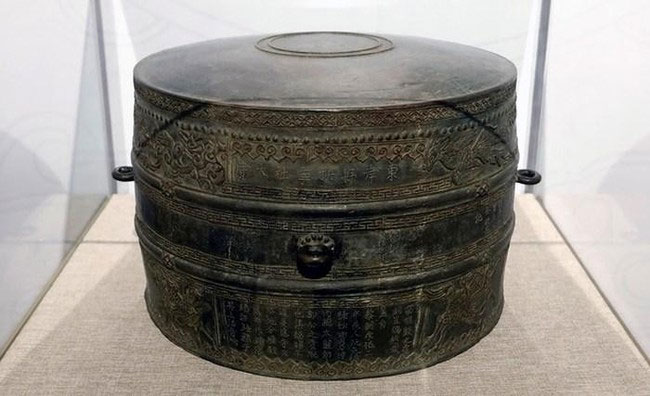
Overview of the national treasure Cảnh Thịnh bronze drum.
Not as ancient as the Đông Sơn or Ngọc Lũ drums, the Cảnh Thịnh bronze drum is the most contemporary archaeological artifact. Following the victory over the Qing Dynasty in 1789, Emperor Quang Trung focused on rebuilding the nation and stabilizing society.
When the emperor passed away in 1792, Quang Toản ascended the throne at the age of 10. During his reign, he established two eras: Cảnh Thịnh and Bảo Hưng. The inscriptions in Chinese characters on the drum indicate that it was cast in April of the eighth year of the Cảnh Thịnh era (1800).
Unique Wax Casting Technique
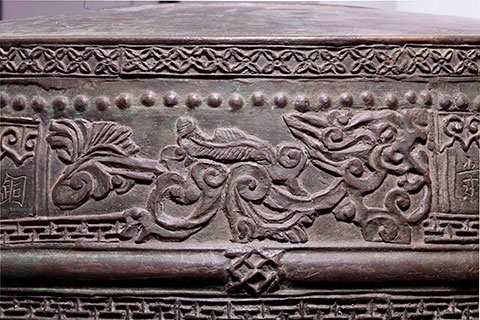
Dragon Leaf Design.
With its unique form and significant historical, cultural, and artistic values, particularly in showcasing the preservation and development of the Vietnamese tradition of casting and using bronze drums over more than two thousand years, the Cảnh Thịnh bronze drum was recognized as a national treasure by the Prime Minister in 2012.
After 222 years, the mysteries of the Cảnh Thịnh bronze drum continue to spark curiosity. From its patterns and designs to its casting purpose and inscriptions, it serves as invaluable documentation not only for archaeologists but also for national history.
According to expert Nguyễn Quốc Hữu, Deputy Head of the Exhibition Department at the National Museum of History, although the Tây Sơn dynasty existed for a brief period, it left behind distinctive cultural heritages. Alongside this were unique artistic masterpieces that clearly reflected the era.
With its unusual shape compared to traditional bronze drums and the prominent decorations of the Four Sacred Animals, the Cảnh Thịnh drum stands out. It reflects creativity in decorative art, casting techniques, and the traditional bronze casting profession of the Vietnamese people. The drum enriches the collection of ancient bronze drums and serves as a valuable historical resource.
According to heritage records, the Cảnh Thịnh bronze drum was cast using the wax casting technique, weighing 32 kg, measuring 37.4 cm in height, and approximately 49 cm in diameter. The surface of the drum is slightly dome-shaped, with a double circle design at its center. The body of the drum is cylindrical, slightly bulging in the middle, and divided into three relatively equal parts, separated by two raised ridges resembling the backs of water buffaloes, with each section featuring a decorative band.
In addition to decorative motifs along the edges like lemon flower bands, nail patterns, and inscriptions, the main decorative theme on the drum appears in two bands: the upper band features the Four Sacred Animals (dragon, unicorn, tortoise, phoenix), symbolizing a peaceful and prosperous nation with harmonious weather, bountiful harvests, and well-fed, long-lived people.
The lower band depicts the Dragon Horse carrying the River Diagram and the Tortoise bearing the Luo Shu. The River Diagram (Xiantian Bagua) and the Luo Shu (Houtian Bagua) are two primordial symbols of the I Ching – an Eastern philosophical thought on the laws of change. These symbols are applied in various fields of life such as cosmology, astronomy, geography, feng shui, human destiny, and social management.
Distinctive Treasure Drum
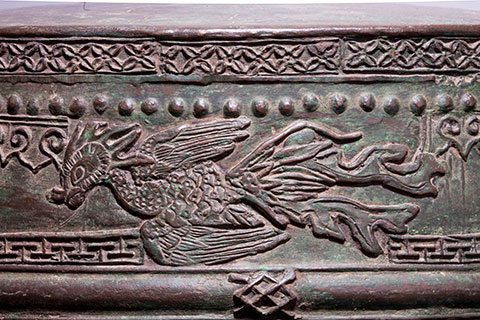
Phoenix motif on the Cảnh Thịnh drum.
According to experts from the National Museum of History, the decorative band features the Thao Thiết motif. The Thao Thiết design has appeared in ancient Vietnamese art since the early centuries AD.
According to legend, Thao Thiết is a gluttonous creature that could even consume its own body. Initially, this decoration served as a reminder of proper eating behavior, but later it became a symbol of strength, authority, and abundance.
The Cảnh Thịnh bronze drum is a unique artifact within the collection of Vietnamese bronze drums. While the Đông Sơn drum (Type I – Heger, dating from around the 7th century BC to the 3rd century AD) and Mường drum (Type II – Heger, dating from the beginning of the Common Era to the 15th – 17th centuries) feature clearly separated sections for the body, belly, and foot, the Cảnh Thịnh drum is designed in the style of traditional skin drums.
This design means that the drum body consists solely of the drum’s shell. In other words, the drum body is the drum shell itself. The drum body bulges slightly in the middle, resembling a typical skin drum. The drum surface also does not feature a sun motif like traditional bronze drums. Instead, two raised circles are located at the center of the domed drum surface.
In addition to its unique shape, the artistry and decorative themes of the drum clearly reflect the artistic characteristics of its time. There is a balance in composition, strength in lines, and mass. Notably, archaeologists have also discovered themes of the Four Sacred Animals and the Dragon Horse, Tortoise.
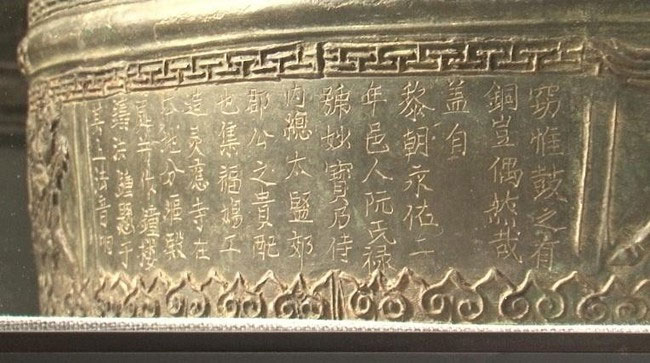
Long inscription explaining the reasons and purposes of casting the drum.
While these individual sacred animals have appeared early in ancient Vietnamese art, the Cảnh Thịnh bronze drum uniquely arranges them into the Four Sacred Animals and pairs the Dragon Horse with the Tortoise, incorporating the River Diagram and Luo Shu on the same artifact. This demonstrates the beginning of a strong development phase in Nguyen-era art.
Notably, the representation of these themes showcases stylized artistry through the designs of sacred animals – such as the Dragon Leaf and the Thao Thiết Leaf. Stylization is a creative ability to refine and enhance reality. The use of flowers and plants to stylize sacred animals, as seen on the Cảnh Thịnh drum, can be considered the first appearance in ancient Vietnamese art.
Alongside its uniqueness and distinctive marks, archaeologists recognize elements of continuity, reflecting a continuous development in traditional art. It is easy to identify decorative bands with nail patterns, lemon flowers, and inscriptions as common motifs in the Ly – Tran – Le periods (11th – 15th centuries).
The image of the phoenix flying sideways, head facing forward, with wings spread wide evokes the image of the Lạc bird on the Đông Sơn bronze drum. The double circle motif on the drum surface is a transformation of the multi-ray sun motif from earlier traditional bronze drums into a sun halo.
Even the drum body, divided into three sections by raised ridges, subtly evokes the three parts of the Đông Sơn bronze drum. This evolution was previously seen in the Mường drum. The back and foot of the Mường drum are created by a continuous, evenly spaced line, making the separation less distinct than in the earlier Đông Sơn drum – represented only by a raised ridge.
Clearly Reflecting Contemporary Techniques
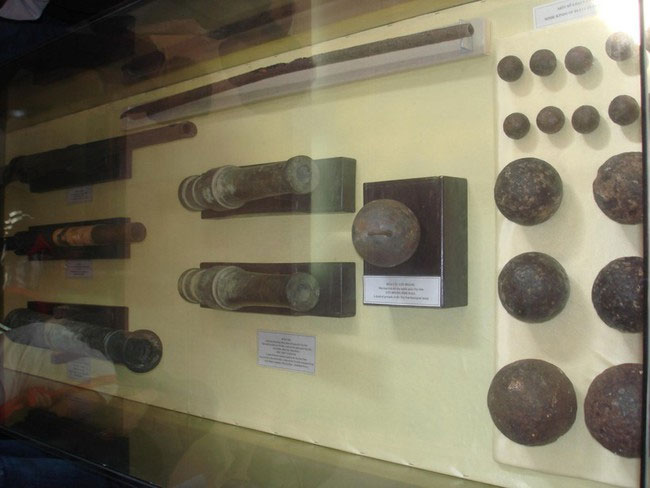
Bronze artifacts (including weapons and ammunition) from the Tây Sơn era clearly demonstrate advanced metalworking techniques.
Another significant value of the Cảnh Thịnh bronze drum lies in its documentation. The inscriptions in Chinese characters indicate the date and location of the drum’s casting. These include: “Dong Co Tan Chu Zuan Shuo,” “Dong Ngan District, Phu Ninh Commune, Dai Tu,” “Cảnh Thịnh 8th year, leap April, auspicious day.”
The inscriptions carved on the body reveal that the drum was cast in the leap month of April in the 8th year of the Cảnh Thịnh era during the Tây Sơn period (1800) at Chùa Cả (Linh Ứng Temple), Phu Ninh Commune, Dong Ngan District, Tu Son Prefecture (now Chùa Nành, Ninh Hiệp Commune, Gia Lâm District, Hanoi).
Notably, a lengthy inscription of over 200 characters explains the reasons and purposes for casting the drum, mentioning a local figure, Mrs. Nguyễn Thị Lộc, wife of the Chief Eunuch Giao Quận Công during the second year of the Vĩnh Hựu era under King Lê Ý Tông (1736), who contributed to the construction of Linh Ứng Temple.
In recognition of her contributions, the people of Phu Ninh Commune collectively contributed their efforts and resources to cast the drum and other ceremonial items to offer to the Buddha, ensuring that future generations remember the merits of their ancestors.
With its unique design compared to traditional bronze drums and the prominent decorations of the Four Sacred Animals, the Cảnh Thịnh drum is distinctive, reflecting creativity in decorative art, casting techniques, and the traditional craft of bronze casting. The drum enriches the collection of ancient bronze drums and serves as a valuable historical resource.
Nonetheless, the Cảnh Thịnh bronze drum is not an exception. Although the Tây Sơn era was brief, lasting just over 10 years (1789 – 1802), it left behind a distinctive artistic legacy. This artistic legacy broke old norms, incorporating everyday prototypes into art more significantly.

















































